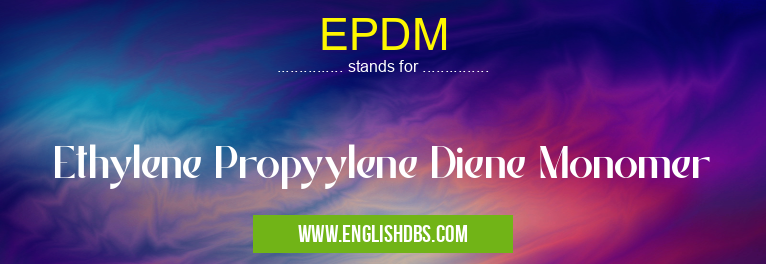What does EPDM mean in UNCLASSIFIED
Ethylene Propylene Diene Monomer (EPDM) is a synthetic rubber widely used in various industrial and consumer applications. It is known for its exceptional resistance to weathering, ozone, and heat, making it an ideal material for outdoor products and harsh environments.

EPDM meaning in Unclassified in Miscellaneous
EPDM mostly used in an acronym Unclassified in Category Miscellaneous that means Ethylene Propyylene Diene Monomer
Shorthand: EPDM,
Full Form: Ethylene Propyylene Diene Monomer
For more information of "Ethylene Propyylene Diene Monomer", see the section below.
Meaning and Significance
- Ethylene: This component provides flexibility and elasticity to the rubber.
- Propylene: It enhances the rubber's strength and resistance to chemicals.
- Diene: This component allows for vulcanization, the process that transforms the rubber into a strong, durable material.
Properties and Applications
EPDM exhibits the following properties:
- Weather Resistance: Excellent resistance to UV radiation, ozone, and extreme temperatures.
- Flexibility: Can withstand repeated bending and stretching without cracking.
- Chemical Resistance: Resists exposure to various chemicals, oils, and solvents.
- Low Cost: Compared to other synthetic rubbers, EPDM is relatively inexpensive to produce.
This combination of properties makes EPDM suitable for a wide range of applications, including:
- Automotive parts (e.g., seals, gaskets, hoses)
- Roofing membranes
- Electrical insulation
- Construction materials (e.g., window profiles, flashings)
- Pond liners
Essential Questions and Answers on Ethylene Propyylene Diene Monomer in "MISCELLANEOUS»UNFILED"
What is EPDM?
Ethylene Propylene Diene Monomer (EPDM) is a synthetic rubber known for its durability and weather resistance. It consists of ethylene, propylene, and diene monomers and is commonly used in various applications, including roofing, automotive parts, and electrical insulation.
What are the key properties of EPDM?
EPDM rubber exhibits exceptional resistance to ozone, UV radiation, and extreme temperatures. It also has excellent electrical insulation properties, making it suitable for use in electrical applications. Additionally, EPDM is known for its flexibility, chemical resistance, and low flammability.
Where is EPDM commonly used?
EPDM finds application in a wide range of industries, including:
- Roofing: EPDM membranes are used in flat or low-slope roofing systems due to their durability and watertightness.
- Automotive parts: EPDM is used in various automotive components, such as hoses, belts, and gaskets, thanks to its resistance to heat and fluids.
- Electrical insulation: EPDM's electrical insulation properties make it suitable for use in wires, cables, and electrical connectors.
- Other applications: EPDM rubber is also used in pond liners, conveyor belts, and printing rollers, among other applications.
What are the advantages of using EPDM?
EPDM offers several advantages, including:
- Durability: EPDM's resistance to ozone, UV radiation, and extreme temperatures ensures a long lifespan.
- Weather resistance: EPDM is well-suited for outdoor applications as it can withstand harsh weather conditions.
- Flexibility: EPDM's flexibility allows for easy installation and adaptability to various shapes and surfaces.
- Chemical resistance: EPDM exhibits resistance to a wide range of chemicals, making it suitable for industrial applications.
- Low flammability: EPDM's low flammability enhances safety in applications where fire resistance is crucial.
Are there any disadvantages to using EPDM?
While EPDM has numerous advantages, there are a few potential disadvantages to consider:
- Cost: EPDM can be more expensive than some other types of synthetic rubber.
- Temperature limitations: EPDM has a maximum continuous service temperature, beyond which its properties may deteriorate.
- Compatibility: EPDM may not be compatible with certain solvents or oils, which can cause degradation.
Final Words: EPDM is a versatile synthetic rubber that plays a crucial role in various industries. Its exceptional resistance to weathering, ozone, and heat makes it an ideal choice for outdoor and harsh environment applications. The low cost and combination of properties further enhance its value and popularity in the market.
